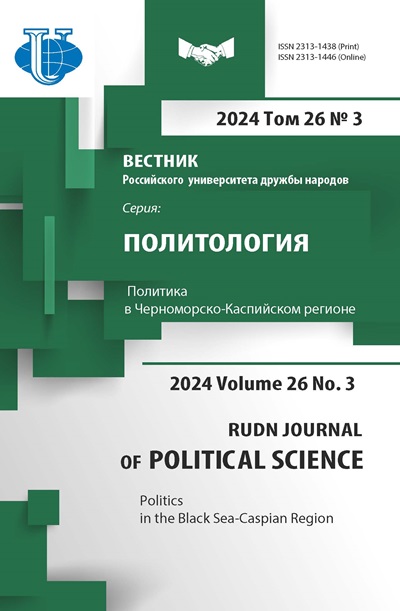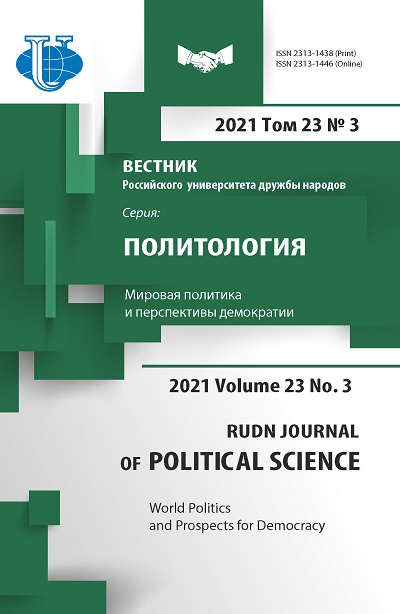Consociational Democracy in Lebanon: Modern Challenges and Development Prospects
- Authors: Kerimov A.A.1
-
Affiliations:
- MGIMO University
- Issue: Vol 23, No 3 (2021): World Politics and Prospects for Democracy
- Pages: 364-378
- Section: GEOPOLITICS AND PROSPECTS FOR DEMOCRACY
- URL: https://journals.rudn.ru/political-science/article/view/27303
- DOI: https://doi.org/10.22363/2313-1438-2021-23-3-364-378
Cite item
Full Text
Abstract
This article explores some key problems of the organization and operation of the Lebanese confessional political system. The study is carried out within the framework of the comparative approach and, in essence, is a comparison of the Lebanese realities with the ideal type of consociational democracy in order to identify country specific features and find ways to overcome the growing instability. Arend Lijphart’s consociational theory is used as the main analytical tool. Based on the analysis of the formation and development of the Lebanese consociational system, the study identifies its historical roots, as well as its strengths and weaknesses. The article examines the internal and external causes of the Lebanese political crises and assesses the possible ways of evolution of the country’s political regime, including the prospects for the transformation of consociational democracy into a civil one. When applied to Lebanon, the terms “consociationalism” and “political confessionalism” are used as synonyms.
About the authors
Arseny A. Kerimov
MGIMO University
Author for correspondence.
Email: senura_msk@mail.ru
ORCID iD: 0000-0001-5491-7736
Attaché of the Embassy of the Russian Federation in the Lebanese Republic, Applicant at the Department of Comparative Politics, MGIMO University
Moscow, Russian FederationReferences
- Kuznetsov, A.A. (2017). Political process in Lebanon at the turn of XX-XXI centuries. Moscow: The Institute of Middle East. (In Russian).
- Lijphart, A. (1997). Democracy in plural societies: A comparative exploration. Moscow: Aspekt Press. (In Russian).
- Kudryashova, I.V., & Kharitonova, O.G. (Eds.). (2020). Metamorphoses of divided societies. Moscow: MGIMO-University. (In Russian).
- Sarabiev, A. (2019). Lebanon: An ordinary “consociational democracy” in the regional context. MGIMO Review of International Relations, 12(4), 89-112. doi: 10.24833/2071-8160-2019-4-67-89-112. (In Russian).
- Abdel-Kader, N. (2010). Multiculturalism and democracy: Lebanon as a case study. Lebanese National Defense Magazine, 72. Retrieved April 12, 2020, from https://www.lebarmy.gov.lb/en/content/ multiculturalism-and-democracy-lebanon-case-study
- Almond, G. (1956). Comparative political systems. Journal of Politics, 18(3), 391-409. doi: 10.2307/2127255
- Balanche, F. (2012). The reconstruction of Lebanon or the racketeering rule. In A. Knudsen, M. Kerr (Eds.), Lebanon after the Cedar revolution. London: C. Hurst & Co. Publishers Ltd.
- Baumann, H. (2019). The causes, nature, and effect of the current crisis of Lebanese capitalism. Nationalism and Ethnic Politics, 25(1), 61-77. doi: 10.1080/13537113.2019.1565178
- Bogaards, M. (2019). Formal and informal consociational institutions: A comparison of the national pact and the Taif agreement in Lebanon. Nationalism and Ethnic Politics, 25(1), 27-42. doi: 10.1080/13537113.2019.1565176
- Calfat, N. (2018). The frailties of Lebanese democracy: Outcomes and limits of the confessional framework. Contexto Internacional, 40(2), 269-293. doi: 10.1590/s0102-8529.2018400200002
- Cammett, M., & Issar, S. (2010). Bricks and mortar clientelism: Sectarianism and the logics of welfare allocation in Lebanon. World Politics, 62(3), 381-421. doi: 10.1017/s0043887110000080
- El-Khazen, F. (2000). The breakdown of the state in Lebanon 1967-1976. Cambridge, MA: Harvard University Press.
- Fakhoury, T. (2014). Debating Lebanon’s power-sharing model: An opportunity or an impasse for democratization studies in the Middle East? The Arab Studies Journal, 22(1), 230-255.
- Horowitz, D. (2000). Ethnic groups in conflict. Berkeley, Calif.: University of California Press.
- Hudson, M. (1976). The Lebanese crisis: The limits of consociational democracy. Journal of Palestine Studies, 5(3-4), 109-122. doi: 10.1525/jps.1976.5.3-4.00p0410r
- Khalaf, S. (1987). Lebanon’s predicament. New York: Columbia University Press.
- Kliot, N. (1987). The collapse of the Lebanese state. Middle Eastern Studies, 23(1), 54-74. doi: 10.1080/00263208708700688
- Koury, E. (1976). The crisis in the Lebanese system. Washington, DC: American Enterprise Institute for Public Policy Research.
- Lehmbruch, G. (1969). Segmented pluralism and political strategies in continental Europe: Internal and external conditions of “concordant democracy”. IPSA Round Table. Turin.
- Lewis, W. (1965). Politics in West Africa. London: Allen and Unwin.
- Lorwin, V. (1971). Segmented pluralism: Ideological cleavages and political cohesion in the smaller European democracies. Comparative Politics, 3(2), 141-175. doi: 10.2307/421297
- Makdisi, U. (2000). The culture of sectarianism. Berkley, Calif.: University of California Press.
- Malik, H. (2000). Between Damascus and Jerusalem. Washington, DC: Washington Institute for Near East Policy.
- Nagle, J., & Clancy, M. (2019). Power-sharing after civil war: Thirty years since Lebanon’s Taif agreement. Nationalism and Ethnic Politics, 25(1), 1-8. doi: 10.1080/13537113.2019.1565171
- Salame, G. (Ed.). (1994). Democracy without democrats? The Renewal of politics in the Muslim World. London: I.B. Tauris.
- Seaver, B. (2000). The regional sources of power-sharing failure: The case of Lebanon. Political Science Quarterly, 115(2), 247-271. doi: 10.2307/2657902
- Traboulsi, F. (2012). A history of modern Lebanon. London: Pluto Press.
















